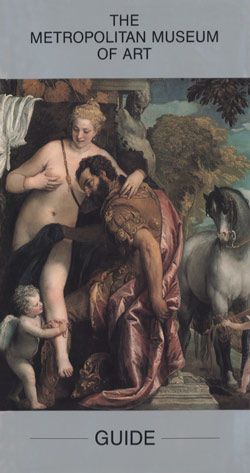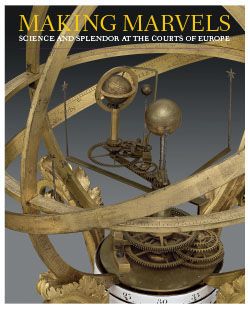Relief mounted as a mirror frame
Wenzel Jamnitzer German
Wenzel Jamnitzer is widely recognized as the greatest Mannerist goldsmith in the German-speaking regions. As demonstrated throughout this volume, much of his fame was based on highly inventive objects, primarily life casts and mounted naturalia for princely Wunderkammern (see, for example, cats. 70–72). The design of this relief frame, with personifications of four of the seven liberal arts—Arithmetic, Geometry, Perspective, and Architec ture— was adopted from the title page of his treatise on geometry, Perspectiva corporum regularium (fig. 85), and it reappears in a similar format as a metal plaque on his tombstone (see cat. 66).[2] The ovoid mirror with faceted glass edges is distinguished by a crowned lion in repoussé silver, a clear reference to Jamnitzer’s maker’s mark, the letter W above a lion mask.[3] A portrait of the artist, or perhaps of a princely first owner, may have been mounted in the oval below. The object was likely the main part of a precious silver book cover that was subsequently reconfigured as a mirror. A silver library was the absolute sign of royal power. Legendary were the book covers of Duke Albert of Prussia, who had texts by Martin Luther enshrined in precious metal.[4]
The ornamental vocabulary of the frame’s moldings document Jamnitzer’s inventiveness and the highly advanced methods of rationalization and prefabrication employed by his workshop (see figs. 26, 29). Thus, various decorative parts that could be shaped to size and applied as fittings appear in a divergent combination of objects (see cat. 14). Jamnitzer’s greatest accomplishments, how-ever, may have been scientific, alongside his talent at bringing together highly skilled craftsmen for masterful collaborations. In 1550 he ordered from another gifted machinist, the inventor Hans Lobsinger— who also produced life casts—a press for working gold, silver, and other metals into a speacific shape.[5] Indeed, as late as 1675, the historian Joachim von Sandrart recommended that young apprentice goldsmiths idolize the universal mind of Wenzel Jamnitzer, and follow him by practicing “drawing, sculpting and other tasks.” [6]
Footnotes
(For figures and referenced additional catalog entries, as well as a key to the shortened bibliography references see Koeppe, Making Marvels: Science & Splendor at the Courts of Europe: The Metropolitan Museum of Art, 2019)
1. Nürnberger Goldschmiedekunst 2007, vol. 1, pt. 1, p. 501 (BZ06) (Nuremberg town mark), p. 203, no. 403.12 (MZ0403) (maker’s mark).
2. Hauschke 2011, p. 97, fig. 3. The design suggests that Jamnitzer was proud of his mastery of geometric perspec-tive; I am grateful to Noam Andrews for his advice.
3. Nürnberger Goldschmiedekunst 2007, vol. 1, pt. 1, pp. 198–205, no. 403, pt. 2, fig. 114.
4. See the silver library of Königsberg; Wo´zniak 2017.
5. Nürnberger Goldschmiedekunst 2007, vol. 1, pt. 1, p. 239, under no. 493. 6. “im Zeichen, Bosiren und andern Regeln.” Quoted in ibid., p. 200.
This image cannot be enlarged, viewed at full screen, or downloaded.
This artwork is meant to be viewed from right to left. Scroll left to view more.





